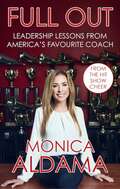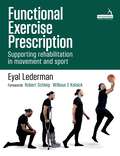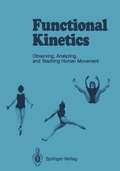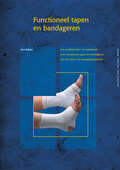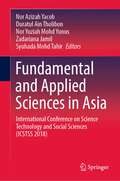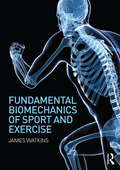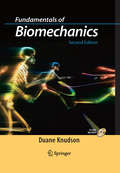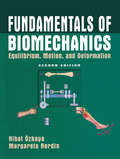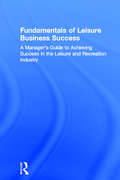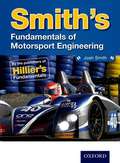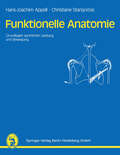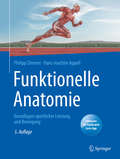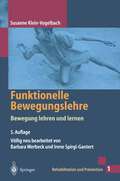- Table View
- List View
Full Out: Leadership lessons from America's favourite coach
by Monica AldamaFrom the breakout star of Netflix's Cheer, a motivational and inspiring guide to becoming a champion in all areas of life.In Full Out, Coach Monica Aldama shares how she built one of the most successful and beloved cheerleading programs in America. Her uncompromising brand of discipline and consistency goes far beyond the mat - showing how the principles of building a winning team apply to personal goals, the corporate world, parenting and all aspects of life.There's a lot of talk these days about short cuts and life hacks, but what really counts is commitment and integrity, helping your friends, and improving with your teammates. Coach Monica shares deeply personal stories of triumph and tragedy from divorce and remarriage to her husband, her challenges as a young mother working more than full time, and her strenuous weeks on Dancing with the Stars. She shares surprising behind-the-scenes moments from the Cheer docuseries, and insights gleaned from more than two decades of pushing students to succeed. A true force and inspiration who has captured hearts around the world, Coach Monica will show you how to take command of your talent, make the most of your potential, and find your drive to win.
FUNCTIONAL ANATOMY (Threshold Picture Guides Ser. #Vol. 43)
by CHRIS COLLESThis reference book outlines the horse's anatomy and physiology and how it works, for horse owners and students. The illustrations are added to by key facts and snippets of information from a leading equine veterinary surgeon.
Functional Anatomy for Sport and Exercise: A Quick A-to-Z Reference
by Clare E. MilnerFunctional Anatomy for Sport and Exercise: A Quick A-to-Z Reference is the most user-friendly and accessible available reference to human musculoskeletal anatomy in its moving, active context. Fully updated and revised, the second edition features more illustrations to enhance student learning and an expanded hot topics section to highlight key areas of research in sport and exercise. An accessible format makes it easy for students to locate clear, concise explanations and descriptions of anatomical structures, human movement terms and key concepts. Covering all major anatomical areas, the book includes: an A-to-Z guide to anatomical terms and concepts, from the head to the foot clear and detailed colour illustrations cross-referenced entries throughout hot topics discussed in more detail in sports examples discussed in more detail full references and suggested further reading This book is an essential quick reference for undergraduate students in applied anatomy, functional anatomy, kinesiology, sport and exercise science, physical education, strength and conditioning, biomechanics and athletic training.
Functional Exercise Anatomy and Physiology for Physiotherapists
by Cetin Sayaca Özden Özkal Abdulhamit Tayfur Filiz Erdem Eyüboğlu Mahmut CalikThis book aims to create a bedside resource for physiotherapists and exercise specialists dealing with a defined movement problem and plan and apply functional therapeutic exercises that can be diversified for the patient.For physiotherapists, exercise is undoubtedly the greatest weapon in treating diseases and improving health. Functional exercise approaches aim to improve physical performance and activities of daily life by adapting exercise prescriptions to the movements that the individual makes frequently in daily life or in sports. The daily activities vary from person to person due to our different habits and lifestyles. Therefore, functional exercise training should be designed differently for everyone. When designing a functional exercise prescription, physiotherapists should consider previous injuries or surgeries that may limit physical activity, as well as general health, muscular strength, endurance and strength, aerobic capacity, and activities that the patient should do in daily life. The functional exercise prescription should be customized considering both the fragility of the patient due to injury or surgery, and the strengths of the patient such as sports/exercise history and healthy eating habits.The book consists of four different parts: the concepts of exercise and physical activity, exercise types, and prescriptions are presented in the first part. The second part is dedicated to musculoskeletal anatomy specific to functional exercise, while the third part explores functional exercise-specific systems physiology and illustrates the compliance of each system with exercise, basic exercise physiology information, and the evaluation and treatment of individuals who are healthy and have diseases that affect each system. Finally, the book has the part of a special topic dealing with nutrition/nutritional supplements affecting recovery in the rehabilitation process after injury or surgery and supporting physical performance during exercise/sports. This book will be of interest to physiotherapists as well as health and sports professionals.
Functional Exercise and Rehabilitation: The Neuroscience of Movement, Pain and Performance
by James CrossleyFunctional training develops the attributes and abilities required to perform tasks, skills and activities useful and relevant to daily life. Functional Exercise and Rehabilitation serves as an accessible and visual guide providing the essentials of therapeutic exercise and rehabilitation, including mobilization, stabilization and myofascial release. This book begins by explaining functional training and the foundation of the STRIVE approach. Chapter 2 introduces functional anatomy and Chapter 3 explains the fundamentals of neuroscience. The final chapters discuss the STRIVE principles and apply them to exercise, program design and injury recovery. Each chapter includes key point boxes, illustrations and photos of exercises discussed. Written by an exercise specialist and osteopath, this practical guide is presented in an easy-to-read style. Functional Exercise and Rehabilitation is essential reading for all health professionals, sports therapists and trainers involved in exercise prescription.
Functional Exercise and Rehabilitation: The Neuroscience of Movement, Pain and Performance
by James CrossleyFunctional training develops the attributes and abilities required to perform tasks, skills and activities useful and relevant to daily life. Functional Exercise and Rehabilitation serves as an accessible and visual guide providing the essentials of therapeutic exercise and rehabilitation, including mobilization, stabilization and myofascial release. This book begins by explaining functional training and the foundation of the STRIVE approach. Chapter 2 introduces functional anatomy and Chapter 3 explains the fundamentals of neuroscience. The final chapters discuss the STRIVE principles and apply them to exercise, program design and injury recovery. Each chapter includes key point boxes, illustrations and photos of exercises discussed. Written by an exercise specialist and osteopath, this practical guide is presented in an easy-to-read style. Functional Exercise and Rehabilitation is essential reading for all health professionals, sports therapists and trainers involved in exercise prescription.
Functional Exercise Prescription: Supporting Rehabilitation in Movement and Sport
by Eyal LedermanIn Functional Exercise Prescription, Eyal Lederman presents a revolutionary new approach for exercise prescription that uses the individual's own movement repertoire. The book demonstrates how daily activities (the life gym) can be amplified to provide the necessary movement challenges to support movement rehabilitation in many musculoskeletal and pain conditions. Hence, all activities can become remedial without the need to prescribe unfamiliar exercise; in other words, 'how to exercise without exercise' or 'how to rehabilitate without exercise'.People recover from most musculoskeletal and pain conditions through three key processes: repair, adaptation, and alleviation of symptoms. The author explains how to identify the individual's recovery process and how to select the appropriate daily or sporting activities, and, how they can be modified to support recovery.Functional Exercise Prescription is a dramatic departure from the traditional strength and conditioning models that have been used for rehabilitation. The book explores the limitation of these models and explains how they can be replaced by functional daily activities ('functioncise'). It provides the practitioner with practical tools to construct a tailor-made plan for each individual to help expedite and optimize their recovery. Most rehabilitation can be constructed from a small familiar set of daily or sports activities.All human physical activity is exercise. Life is your gym.
Functional Kinetics: Observing, Analyzing, and Teaching Human Movement
by Susanne Klein-VogelbachSusanne Klein-Vogelbach's acclaimed textbook describing her concept of functional kinetics!The well-known physiotherapist presents her theory concerning the systematic observation and analysis of human movement. The purpose of functional kinetics is to improve observation, analysis and instruction of human movement. The physiotherapist must be able to analyse movement in order to find and define the functional problem. She or he must be able to effect the required change in movement, whether through manipulation, instructing the patient how to move or both.The ideas outlined in this book are basic to physical therapy and rehabilitation and should be familiar to every active therapist.
Functioneel tapen en bandageren: Een praktisch leer- en oefenboek voor functioneel tapen en bandageren van het steun- en bewegingsapparaat
by A. BakkerHet onderdeel tapetechnieken in de fysiotherapie wordt zowel nationaal als internationaal vooral geassocieerd met sportletsels. Ook in het leven van alledag komen echter veelvuldig klachten van het bewegingsapparaat voor die met behulp van een tape of een bandage kunnen worden behandeld. Tevens worden tapetechnieken niet alleen als behandeling van een letsel toegepast maar zeker in de sportbeoefening vaak ook preventief. In deze uitgave wordt met duidelijke foto's weergegeven hoe tapetechnieken gebruikt kunnen worden om een blessure te verlichten. Hierin wordt elke tape-techniek zowel in beeld als in woord stap-voor-stap uitgelegd, zodat men een goed beeld krijgt hoe bandages en tapes voor een goed resultaat kunnen worden aangelegd.
Fundamental and Applied Sciences in Asia: International Conference on Science Technology and Social Sciences (ICSTSS 2018)
by Nor Azizah Yacob Duratul Ain Tholibon Nor Yuziah Mohd Yunus Zadariana Jamil Syuhada Mohd TahirThis book gathers selected science and technology papers presented at the 2018 International Conference on Science Technology and Social Sciences (ICSTSS 2018), organised bi-annually by Universiti Teknologi MARA Pahang, Malaysia. Based on the theme “Redesigning Education for Industrial Revolution”, the papers in this book address a broad range of topics in the fundamental and applied sciences, including computer science, engineering, environmental and management, furniture, forestry, health and medicine, material science, mathematics, plantation and agrotechnology, sport science and statistics, covering theoretical, numerical and experimental studies. The book serves as a platform for disseminating research findings by academicians of local, regional and global prominence, as a catalyst to inspire positive innovations in the development of the region. It provides a significant point of reference for academicians and students: for academicians, it is a good source of information to conduct further research; for students, it is the latest point of reference on research conducted in their fields of study. The carefully reviewed papers intend to facilitate the creation of new knowledge through the exchange of ideas, strategies and innovations in various science and technology disciplines, and to contribute towards enhancing the learning environment.
Fundamental Biomechanics of Sport and Exercise
by James WatkinsFundamental Biomechanics of Sport and Exercise is an engaging and comprehensive introductory textbook that explains biomechanical concepts from first principles, showing clearly how the science relates to real sport and exercise situations. The book is divided into two parts. The first provides a clear and detailed introduction to the structure and function of the human musculoskeletal system and its structural adaptations, essential for a thorough understanding of human movement. The second part focuses on the biomechanics of movement, describing the forces that act on the human body and the effects of those forces on the movement of the body. Every chapter includes numerous applied examples from sport and exercise, helping the student to understand how mechanical concepts describe both simple and complex movements, from running and jumping to pole-vaulting or kicking a football. In addition, innovative worksheets for field and laboratory work are included that contain clear objectives, a description of method, data recording sheets, plus a set of exemplary data and worked analysis. Alongside these useful features are definitions of key terms plus review questions to aid student learning, with detailed solutions provided for all numerical questions. No other textbook offers such a clear, easy-to-understand introduction to the fundamentals of biomechanics. This is an essential textbook for any biomechanics course taken as part of degree programme in sport and exercise science, kinesiology, physical therapy, sports coaching or athletic training.
Fundamental Biomechanics of Sport and Exercise
by James WatkinsFundamental Biomechanics of Sport and Exercise is an engaging and comprehensive introductory textbook that explains biomechanical concepts from first principles, showing clearly how the science relates to real sport and exercise situations. The book is divided into two parts. The first provides a clear and detailed introduction to the structure and function of the human musculoskeletal system and its structural adaptations, essential for a thorough understanding of human movement. The second part focuses on the biomechanics of movement, describing the forces that act on the human body and the effects of those forces on the movement of the body. Every chapter includes numerous applied examples from sport and exercise, helping the student to understand how mechanical concepts describe both simple and complex movements, from running and jumping to pole-vaulting or kicking a football. In addition, innovative worksheets for field and laboratory work are included that contain clear objectives, a description of method, data recording sheets, plus a set of exemplary data and worked analysis. Alongside these useful features are definitions of key terms plus review questions to aid student learning, with detailed solutions provided for all numerical questions. No other textbook offers such a clear, easy-to-understand introduction to the fundamentals of biomechanics. This is an essential textbook for any biomechanics course taken as part of degree programme in sport and exercise science, kinesiology, physical therapy, sports coaching or athletic training.
Fundamental Karate
by Aidan Trimble Dave HazardThis easy-to-follow guide is an essential reference for practitioners of all ages and abilities of this most popular martial art. Beginning with a chapter on breathing technique, this practical and detailed book goes on to reveal how to develop your energy-shout, the basic stances of Karate and how to accomplish the art of punching, blocking, kicking and striking, including all the must-know moves from the Knife-hand Block to the Roundhouse Kick. Each stance and movement is complimented with clear step-by-step photographs and includes a section on 'points to avoid' when practising each one. By demonstrating the key aspects of the basic technique and emphasising the need for a careful, classical approach to the practice of Karate, you will have all you need to know to practise the sport in safety. Coming from two of the UK's most respected and experienced competitors and teachers, this is the perfect guide for both new and improving students of Karate.
Fundamentals of Biomechanics
by Duane KnudsonBlending up-to-date biomechanical knowledge with professional application knowledge, this second edition presents a clear, conceptual approach to understanding biomechanics within the context of the qualitative analysis of human movement. It develops nine principles of biomechanics, which provide an applied structure for biomechanical concepts, and the application of each principle is fully explored in several chapters. The book also offers real-world examples of the application of biomechanics, which emphasize how biomechanics is integrated with the other subdisciplines of kinesiology to contribute to qualitative analysis of human movement.
Fundamentals of Biomechanics
by Duane KnudsonBlending up-to-date biomechanical knowledge with professional application knowledge, this second edition presents a clear, conceptual approach to understanding biomechanics within the context of the qualitative analysis of human movement. It develops nine principles of biomechanics, which provide an applied structure for biomechanical concepts, and the application of each principle is fully explored in several chapters. The book also offers real-world examples of the application of biomechanics, which emphasize how biomechanics is integrated with the other subdisciplines of kinesiology to contribute to qualitative analysis of human movement.
Fundamentals of Biomechanics: Equilibrium, Motion, and Deformation
by Dawn L. LegerExtensively revised from a successful first edition, this book features a wealth of clear illustrations, numerous worked examples, and many problem sets. It provides the quantitative perspective missing from more descriptive texts, without requiring an advanced background in mathematics, and as such will be welcomed for use in courses such as biomechanics and orthopedics, rehabilitation and industrial engineering, and occupational or sports medicine.
Fundamentals of Biomechanics: Equilibrium, Motion, and Deformation
by Nihat Özkaya Dawn Leger David Goldsheyder Margareta NordinThis textbook integrates the classic fields of mechanics—statics, dynamics, and strength of materials—using examples from biology and medicine. The book is excellent for teaching either undergraduates in biomedical engineering programs or health care professionals studying biomechanics at the graduate level. Extensively revised from a successful third edition, Fundamentals of Biomechanics features a wealth of clear illustrations, numerous worked examples, and many problem sets. The book provides the quantitative perspective missing from more descriptive texts, without requiring an advanced background in mathematics. It will be welcomed for use in courses such as biomechanics and orthopedics, rehabilitation and industrial engineering, and occupational or sports medicine.This book:Introduces the fundamental concepts, principles, and methods that must be understood to begin the study of biomechanicsReinforces basic principles of biomechanics with repetitive exercises in class and homework assignments given throughout the textbookIncludes over 100 new problem sets with solutions and illustrations
Fundamentals of Biomechanics: Equilibrium, Motion, and Deformation
by Nihat Özkaya Margareta Nordin David Goldsheyder Dawn LegerBiomechanics applies the principles and rigor of engineering to the mechanical properties of living systems. This book integrates the classic fields of mechanics--statics, dynamics, and strength of materials--using examples from biology and medicine. Fundamentals of Biomechanics is excellent for teaching either undergraduates in biomedical engineering programs or health care professionals studying biomechanics at the graduate level. Extensively revised from a successful first edition, the book features a wealth of clear illustrations, numerous worked examples, and many problem sets. The book provides the quantitative perspective missing from more descriptive texts, without requiring an advanced background in mathematics. It will be welcomed for use in courses such as biomechanics and orthopedics, rehabilitation and industrial engineering, and occupational or sports medicine.
The Fundamentals of Hogan
by David LeadbetterBen Hogan’s The Modern Fundamentals of Golf is the best-selling sports book ever, with over six million copies sold worldwide. This sequel to the original book offers previously unpublished photographs and the expert commentary of David Leadbetter.
Fundamentals of Leisure Business Success: A Manager's Guide to Achieving Success in the Leisure and Recreation Industry
by William WinstonEasy to read and conducive to discussion, Fundamentals of Leisure Business Success: A Manager‘s Guide to Achieving Success in the Leisure and Recreation Industry takes a practical, upbeat look at the worlds largest industry--leisure and recreation--and gives you practical tips and surefire strategies for making your own profit or nonprofit leisure
Fundamentals Of Motorsport Engineering (PDF)
by Josh SmithSmith's Fundamentals of Motorsport Engineering provides the ultimate guide to motorsport engineering and what to expect at the racetrack, with content to suit motorsport learners from Level 3 up to degree level. This new textbook provides Motorsports students and practitioners with the fundamental theory necessary to work and advance in the industry.
Fundamentals of the Shoulder
by Gazi Huri Mustafa Özkan Kerem BilselThis book comprehensively covers both basic and clinical aspects of the shoulder, from its anatomy and biomechanics, to the diagnosis and treatment of a broad range of shoulder disorders. Designed as a practical and richly illustrated reference guide, it provides the reader with the essentials needed to evaluate and treat shoulder injuries, including radiologic assessments, rehabilitative techniques and surgical procedures (both open and arthroscopic). It includes extensive coverage of the anatomy and pathology, while clinical topics covered include fractures around the shoulder joint, sport injuries and arthroplasty. Written by an international team of experts, who share tips, pearls and pitfalls, as well as best practices from their own experience, the book will be of interest to orthopedic surgeons, physical therapists, rehabilitation specialists and biomechanists alike.
Funktionelle Anatomie: Grundlagen sportlicher Leistung und Bewegung
by H.-J. Appell C. Stang-Voss"Was man nicht weiß, das eben brauchte man, und was man weiß, kann man nicht brauchen. " Dieses Wort aus Goethes "Faust" spiegelt ange sichts des heterogenen Schrifttums zu den anatomischen Grundlagen des Sports wohl treffend die Lage wider, in der sich Lehrende und Ler nende in diesem Bereich befinden. Die hauptsächlich für Mediziner ver faßten Lehrbücher der Anatomie behandeln das Fach überwiegend nach deskriptiven und topographischen Gesichtspunkten, andere "Sportanatomien" scheinen gelegentlich im Bestreben nach Praxisnähe allzu populärwissenschaftlich verlaßt. Dies war Anlaß genug, den außerordentlich umfangreichen Stoff der Anatomie des Bewegungs apparates, des Nervensystems (soweit für die Motorik wichtig) und der Organsysteme unter funktionellen Gesichtspunkten für den Sport dar zustellen. Die gewählte Vorgehensweise beschränkt sich nicht nur auf das "Wie", sondern versucht - wo möglich und nötig -, auch das "Warum" zu erläutern. Notwendigerweise mußten Kompromisse zwi schen Vollständigkeit und Übersichtlichkeit gemacht werden. So wur den die histologischen Grundlagen nur für die Gewebe des aktiven und passiven Bewegungsapparates ausführlicher behandelt und in den ande ren Kapiteln, sofern zum Verständnis der Funktion erforderlich, nur kurz umrissen. Die Darstellung des Zentralnervensystems orientierte sich eng an der Motorik, wobei die Abhandlung anatomischer Einzel heiten hinter den physiologischen Funktionszusammenhängen zurück stehen mußte. Auch das Kapitel über die Organsysteme konnte nur jene berücksichtigen, die für weiterführende Studien zur Anpassung des Organismus an Leistung innerhalb der Sportmedizin von Bedeutung sind. Die Beantwortung der Fragen nach biochemischen und komplexen physiologischen Prozessen muß den Lehrbüchern jener Disziplinen vor behalten bleiben.
Funktionelle Anatomie: Grundlagen sportlicher Leistung und Bewegung
by Philipp Zimmer Hans-Joachim AppellWie funktioniert der menschliche aufrechte Gang? Welche Muskeln sind beteiligt? Wie werden die auf den Fuß einwirkenden Kräfte beim Lauf abgefedert? Experten erläutern hier alle grundlegenden und wichtigen Details zu Aufbau und Funktion des menschlichen Körpers: das Zusammenspiel der Bestandteile des Bewegungsapparates – Knochen, Sehnen und Muskeln, die Bewegungssteuerung und -kontrolle durch das Zentrale Nervensystem sowie alle für sportliche Leistung und Bewegung notwendigen Körpersysteme.Die 5. Auflage wurde komplett überarbeitet und enthält Prüfungsfragen, die über die App Springer Nature Flashcards abgerufen werden können. Der eigene Wissenstand zu einem Thema kann mittels Fragen und Antworten einfach und spielerisch abgefragt werden.
Funktionelle Bewegungslehre: Bewegung lehren und lernen (Rehabilitation und Prävention #1)
by Susanne Klein-VogelbachVon B. Werbeck und I. Spirgi-Gantert völlig neu bearbeitet und inhaltlich wie formal rundum modernisiert:- besser lesbar und leichter zugänglich- mit farbigen Lernhilfen und Zeichnungen- praxisbezogen durch zahlreiche Beispiele- Neu: Grundlagen der Gangschulung und Ausblicke auf Behandlungstechniken und ÜbungenAls Standardwerk in der Physiotherapie leitet es Therapeuten in der Ausbildung an,o normale und von der Norm abweichende Bewegung und Haltung präzise zu beobachten,o dem Patienten in der Behandlung richtiges Bewegungsverhalten zu vermitteln undo seine aktive Wahrnehmung dafür zu schulen.
